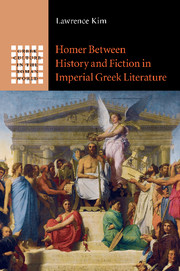Book contents
- Frontmatter
- Contents
- Acknowledgments
- Note on texts, translations, and abbreviations
- 1 Introduction: Imperial Homer, history, and fiction
- 2 Homer, poet and historian: Herodotus and Thucydides
- 3 Homer, the ideal historian: Strabo's Geography
- 4 Homer the liar: Dio Chrysostom's Trojan Oration
- 5 Homer on the island: Lucian's True Stories
- 6 Ghosts at Troy: Philostratus' Heroicus
- 7 Epilogue
- Works cited
- Index
- Index locorum
2 - Homer, poet and historian: Herodotus and Thucydides
Published online by Cambridge University Press: 06 December 2010
- Frontmatter
- Contents
- Acknowledgments
- Note on texts, translations, and abbreviations
- 1 Introduction: Imperial Homer, history, and fiction
- 2 Homer, poet and historian: Herodotus and Thucydides
- 3 Homer, the ideal historian: Strabo's Geography
- 4 Homer the liar: Dio Chrysostom's Trojan Oration
- 5 Homer on the island: Lucian's True Stories
- 6 Ghosts at Troy: Philostratus' Heroicus
- 7 Epilogue
- Works cited
- Index
- Index locorum
Summary
For the ancients, Homeric poetry depicted real historical people and events. As Carlo Brillante puts it, the Greeks of the Classical period “imagined their heroes as men who had actually lived, inhabiting the same cities and regions in which they themselves, several centuries later, continued to reside.” By the Imperial era, physical evidence of the heroic past was everywhere: a papyrus letter in Lycia written by Sarpedon, the tusks of the Calydonian boar in Beneventum, the anchor of the Argo at the mouth of the Phasis. The precise locations of heroic activity, such as the bronze floor of Agamemnon's tent at Aulis (Paus. 9.19.5), were carefully preserved, marked out, and displayed to tourists and travelers; the heroes themselves, in their tombs, or else as the dedicatees of cults, were visited and venerated. The establishment of coherent heroic ‘family trees’ and genealogies situating the heroes in time and linking them to particular cities and geographical areas contributed to the perception of their reality. On a more quotidian level, the heroic world intruded into ancient social life – from public art to religious practices and ritual, as a source of paradeigmata in philosophical discourses, rhetorical displays, and moral diatribes, and as the subject-matter of the epic and tragic poetry which formed the backbone of the Greek and Roman educational system. The historicity of the heroic age was thus taken for granted: it had left visible, tangible traces; it had a relative chronology and had taken place in identifiable locales; unbroken lines of descent linked it to contemporary Greek society, and it formed the subject matter of an authoritative poetic and religious tradition.
- Type
- Chapter
- Information
- Publisher: Cambridge University PressPrint publication year: 2010

